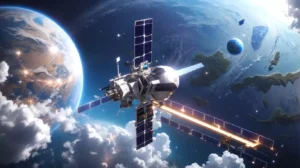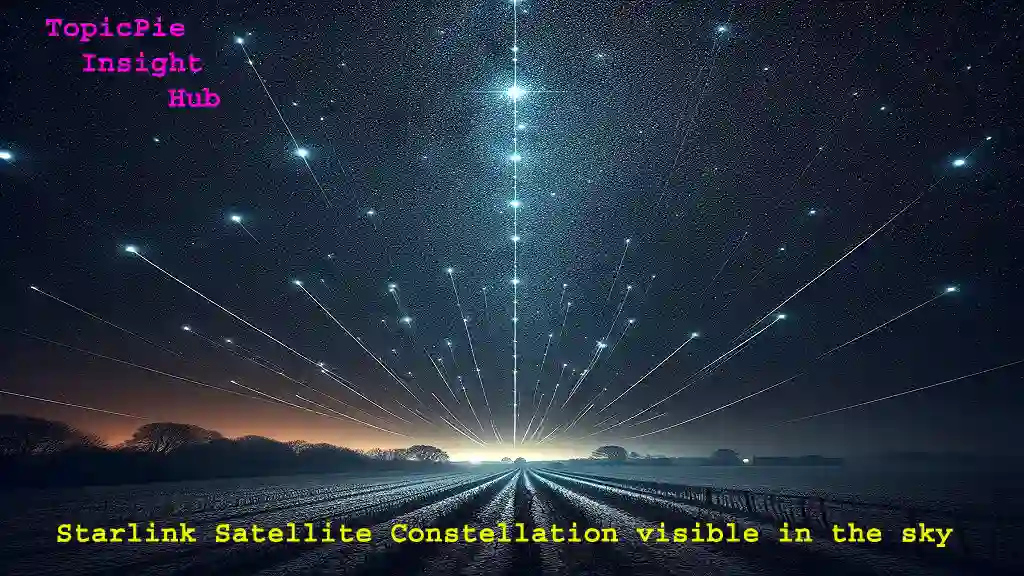Imagine a world where internet connectivity knows no boundaries. In a connected world, every corner of the planet is seamlessly linked, offering endless possibilities to individuals and communities. Empowering people and communities, this connectivity spans every nook and cranny, unlocking vast opportunities for growth and collaboration. Thanks to Starlink satellite technology, this vision is becoming a reality.
In our increasingly digital age, reliable high-speed internet is essential for education, communication, and business growth. Unfortunately, millions worldwide struggle with limited connectivity, creating the “digital divide.” But fear not! Starlink satellite service is here to bridge the gap, extending the benefits of cyberspace. It reaches remote corners of our planet, bringing connectivity to underserved areas.
Embark on an exciting journey into the realm of Starlink satellites. Explore their rapid global growth and influence. Delve into cutting-edge services, availability, and groundbreaking technology launches. Understand their impact on astronomy and satellite collision risk. Compare them against traditional internet services. Witness their glory in the night sky. Explore tools tracking coverage areas and find additional resources for more knowledge about this revolutionary venture. So fasten your seatbelts – we’re about to embark on an interstellar adventure through cyberspace!
What is Starlink?
What exactly is Starlink, you ask? Well, in simple terms, it’s a satellite constellation developed by SpaceX – Elon Musk’s pioneering aerospace company. Instead of relying on traditional ground-based infrastructure for internet connectivity, Starlink utilizes a network of thousands of small satellites orbiting the Earth.
These satellites work together to provide global broadband coverage with impressive speed and reliability. By beaming internet signals from space directly to user terminals on the ground, Starlink overcomes the limitations posed by the physical infrastructure required for traditional internet services.
One might wonder why we need such an extensive satellite network when there are already existing methods for connecting to the internet. The answer lies in reaching areas where conventional methods simply fall short. Remote regions that lack fiber-optic cables or cell towers can now harness the power of high-speed internet thanks to this revolutionary technology.
But it doesn’t stop there! Starlink aims to go beyond bridging gaps in rural and underserved areas; it also has ambitions for urban centers where congestion can strain existing networks. With its scalable architecture and ambitious plans for expansion, Starlink has set out to revolutionize global connectivity as we know it.

Stay tuned as we delve deeper into its rapid growth and influence worldwide!
Starlink Satellite: A Meteoric Surge and Global Influence:
Over the past few years, Starlink has experienced rapid growth and has been making waves in the tech world. This satellite internet constellation system is revolutionizing connectivity on a global scale. With its ambitious goal of providing high-speed broadband access to even the most remote areas of the world, Starlink is bridging the digital divide like never before.
One of the key factors contributing to Starlink’s rapid growth is its aggressive launch schedule. SpaceX, the company behind Starlink, has been launching batches of satellites into orbit at an impressive pace. Each batch consists of 60 satellites, and as of now, there are already thousands in orbit. This swift deployment allows for increased coverage and faster service rollout.
The influence of Starlink can be seen across various sectors. In rural areas where traditional internet infrastructure may be lacking or non-existent, Starlink provides a lifeline for businesses, students, and individuals who rely on fast internet connections for work or education. It also paves the way for advancements in telemedicine, e-commerce, agriculture technology, and more.
Moreover, governments around the world have recognized the potential impact that widespread access to reliable internet can have on their economies and societies. Many countries have partnered with SpaceX to bring affordable high-speed internet access to their citizens through initiatives like “Starlink Beta.”
As more users join this networked ecosystem powered by thousands of satellites circling above us all day long and night too‚ the influence will only continue to grow exponentially.
In summary, Starlink’s rapid growth showcases its commitment towards providing global connectivity solutions effectively. Through frequent satellite launches and expanding coverage areas worldwide it has established itself as a leading player in bridging the digital divide globally while influencing various industries positively.
Starlink’s Services and Availability:
When it comes to bridging the digital divide, Starlink is making significant strides with its revolutionary satellite internet service. Unlike traditional providers that rely on ground-based infrastructure, Starlink operates a constellation of thousands of small satellites orbiting the Earth. This allows them to provide high-speed internet access to even the most remote areas where connectivity was previously limited or non-existent.
One of the biggest advantages of Starlink’s services is its global coverage. As more satellites are deployed into space, users around the world will have access to fast and reliable internet connection regardless of their location. Whether you live in a rural village or on a boat in the middle of an ocean, Starlink promises to keep you connected.
Availability plays a crucial role in any internet service, and Starlink understands this well. To ensure widespread availability, they have been launching batches of satellites into low Earth orbit at regular intervals. As these satellites populate different orbital planes, it enables seamless coverage across various geographical locations.
To subscribe to Starlink’s services, all you need is their user terminal (a dish-like device) and a subscription plan. The user terminal communicates with nearby satellites and provides internet connectivity for your devices through Wi-Fi or wired connections.
With its ambitious plans for further satellite deployment and continuous improvements in technology, Starlink aims to expand its services globally while maintaining affordable pricing options. By doing so, they hope to bridge not only the digital divide but also narrow down economic disparities caused by unequal access to information and opportunities.
In short, as long as there is clear sky above you (no tall structures blocking communication), chances are that you can benefit from Starlink’s game-changing satellite internet service!
Starlink’s Technology and Launches:

The technology behind Starlink’s satellite internet network is truly revolutionary. Instead of relying on traditional ground-based infrastructure, Starlink uses a constellation of small satellites in low Earth orbit (LEO). These satellites work together to provide global coverage and high-speed internet access.
One of the key advantages of this LEO configuration is reduced latency. Because the satellites are closer to Earth than traditional geostationary satellites, signals travel shorter distances, resulting in faster response times for users. This makes activities like video conferencing and online gaming much smoother and more enjoyable.
To launch its satellite fleet, SpaceX, the company behind Starlink, has been conducting regular Falcon 9 rocket launches. Each launch carries multiple Starlink satellites into space, gradually building up the network’s capacity. So far, SpaceX has successfully launched hundreds of these small spacecrafts.
What sets these satellites apart is their compact size and advanced design features. They are equipped with powerful onboard processors that allow them to communicate with each other as well as with ground stations on Earth.
SpaceX continues to refine its technology through iterative design improvements and software updates deployed remotely to the satellite fleet already in orbit. This approach enables rapid innovation while minimizing costs associated with physical upgrades or replacements.
In addition to launching new satellites regularly, SpaceX also prioritizes reusability when it comes to their rockets. By landing and refurbishing Falcon 9 boosters after each launch instead of discarding them like single-use rockets do, they significantly reduce costs associated with space missions.
With ongoing technological advancements, Starlink has an ambitious deployment plan aiming for tens of thousands of operational satellites. The mission persists, with no signs of slowing down. Starlink aims to bridge the global digital divide, providing fast and reliable internet access in once-challenging remote areas.
The Starlink Satellite: Effects on Astronomy and Risks of Satellite Collisions
Starlink, the satellite internet constellation project by SpaceX, has been making waves in the tech world. While it promises to bring high-speed internet to underserved areas and bridge the digital divide worldwide, there are concerns about its impact on astronomy and satellite collision risk.
The sheer number of Starlink satellites being launched into space is raising concerns among astronomers. These satellites can be visible as streaks of light in astronomical images, potentially disrupting observations and hindering our understanding of the universe. Astronomers have raised their voices against this issue, urging for regulations to reduce the brightness of these satellites.
Another significant concern is the increased risk of satellite collisions. With thousands of Starlink satellites orbiting Earth at low altitudes, the chance of collisions increases with space objects or debris. This elevated risk could lead to a cascading effect known as Kessler Syndrome. One collision trigger more, creating an impenetrable field of debris around our planet.
SpaceX has taken some steps to address these concerns. They are actively working on reducing the reflectivity or “brightness” of their satellites through experimental coatings or visors that block sunlight from hitting reflective surfaces. Additionally, they’re collaborating with scientists and astronomers worldwide to find solutions that minimize interference with astronomical observations.
Despite these efforts, it’s crucial for regulators and policymakers to collaborate. They should establish guidelines to balance global connectivity through Starlink while preserving scientific research in astronomy without endangering our orbital environment.
As technology rapidly advances, society must carefully weigh the benefits and potential consequences. This includes embracing innovations like Starlink. It’s essential for us to consider the impacts before fully adopting new technologies into our daily lives.
Starlink vs. Traditional Internet Services
The advent of Starlink satellite internet has sparked a new wave of excitement in the world of connectivity. But how does it stack up against traditional internet services? Let’s explore.
Speed is one area where Starlink shines. With its constellation of satellites orbiting Earth, it promises high-speed internet access even in remote areas that are underserved by traditional providers. No longer will rural communities have to settle for sluggish connections or rely on dial-up speeds.
Reliability is another key factor. While traditional broadband connections can be prone to outages and disruptions, especially during severe weather events, Starlink’s network is designed to provide a more resilient and robust connection. This means fewer interruptions when you’re streaming your favorite show or working from home.
Cost is always an important consideration when comparing different internet options. Currently, the cost of accessing Starlink can be higher than what people are accustomed to paying for traditional broadband services. However, as the technology matures and more satellites are deployed, prices are expected to become more competitive.
One advantage that traditional internet services still hold over Starlink is coverage area. While Starlink aims to provide global coverage eventually, it’s currently only available in select regions around the world. So, if you live outside these areas, you may have no choice but to stick with a traditional provider for now.
In terms of installation and setup, both options require some initial effort from users. Traditional providers send technicians to install equipment. In contrast, Starlink users set up their own satellite dish using SpaceX’s detailed instructions.
While there are pros and cons associated with both types of services, Starlink has disrupted the telecom industry. Its speed, reliability (weather-dependent), and potential global reach make it an enticing option for faster, more accessible internet connectivity.
How to See and Track Starlink Satellites in the Night Sky:
Have you ever wondered how to spot those streaks of light moving across the night sky? Well, with the rapid growth of Starlink satellite constellations, it’s becoming increasingly common to witness these celestial phenomena. If you’re eager to catch a glimpse of Starlink satellites in action, here are some tips on how to see and track them!
Timing is everything. To increase your chances of spotting a Starlink satellite, check online resources or smartphone apps that provide real-time tracking information. These tools can tell you when and where the satellites will pass overhead based on your location.
Once you have the timing down, find an area away from city lights with a clear view of the horizon. Dark skies make it easier to spot these fast-moving objects against the backdrop of stars.
When searching for Starlink satellites, keep an eye out for strings or trains of bright dots moving across the sky in a straight line. The satellites often appear as a chain-like formation due to their close proximity and orbital patterns.
It’s important to note that visibility may vary depending on factors such as atmospheric conditions and satellite positioning. Be patient and give yourself plenty of time during each viewing window.
If you’re lucky enough to spot one (or several) Starlink satellites passing overhead, take a moment to appreciate this feat of engineering! These tiny specks represent humanity’s growing efforts towards bridging the digital divide worldwide.
So, grab your telescope or just use your naked eye – get ready for some stargazing excitement as you track those mesmerizing Starlink satellites through our beautiful night skies!
Starlink Coverage Tracker and Simulation:
One of the exciting features that Starlink offers is its coverage tracker and simulation tool. With this tool, users can determine if they are within the coverage area for Starlink’s satellite internet service. This is especially helpful for those who live in remote areas or regions with limited access to traditional internet services.
The coverage tracker provides real-time information on where Starlink satellites are currently positioned in orbit. Users simply enter their location, and the tool will generate a map displaying the projected coverage area based on the current satellite constellation.
Additionally, Starlink’s simulation feature lets users visualize the impact of added satellites. Adjust altitude and numbers to gauge connectivity changes. This tool helps users understand how changes in satellite quantity and altitude affect their connectivity options.
This tool not only helps potential customers determine if they can benefit from Starlink’s services but also provides valuable data for ongoing network optimization. As SpaceX continues to launch more satellites into space, it is crucial to ensure maximum coverage and efficiency.
To access the coverage tracker and simulation tools, interested individuals can visit the official Starlink website or download the dedicated mobile app available for both Android and iOS devices.
Explore More About Starlink Satellite: Resources for In-Depth Information and Updates
If you want to dive deeper into the world of Starlink and stay up-to-date with all the latest developments, there are several resources you can explore. Here are a few places where you can learn more about Starlink:
1. Official SpaceX Website: The official SpaceX website provides detailed information about Starlink’s mission, technology, and coverage areas. You can find answers to frequently asked questions and get insights straight from the source.
2. Elon Musk’s Twitter Account: Elon Musk, the founder of SpaceX, often shares updates and news about Starlink on his Twitter account (@elonmusk). Following him will give you real-time information and glimpses into the future plans for this groundbreaking satellite network.
3. Reddit Community: Joining online communities like r/Starlink on Reddit allows you to connect with other enthusiasts who share your interest in space technology. Here, you can participate in discussions, ask questions, and gain valuable insights from people who closely follow Starlink’s progress.
4. YouTube Channels: There are several YouTube channels dedicated to covering news related to space exploration and technology advancements. Subscribing to popular channels like Everyday Astronaut or Scott Manley will ensure that you never miss out on any important updates regarding Starlink.
5. Academic Research Papers: For those looking for a more technical understanding of how Starlink works or its impact on various fields such as telecommunications or astronomy, exploring academic research papers is an excellent option. Websites like Google Scholar provide access to scholarly articles written by experts in their respective domains.
Also Read: How ChatGPT Transforms Human-Machine Interactions: The Future is Here
By delving into these resources, you’ll be able to expand your knowledge about every aspect of Starlink – from its technological innovations to its potential implications for bridging the digital divide worldwide.
So go ahead and embark on your journey towards becoming a true star gazer! Explore these sources of information today and join millions around the globe who eagerly anticipate the continued growth and success of Starlink. The sky is no longer a limit; it marks just the commencement of new possibilities and exploration.








